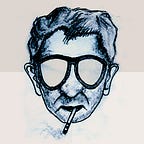As I write this it's that time of year:
The time for resolutions, for betterment of the self in hope of bettering the world: the beginning of a new one; for some, still infused with dreams of one that's better than the last, and for others already the beginning of the doldrums and the bleak realization that nothing will change, that time will crush all optimism and things, as always, will continue to fall apart.
It’s at times like these, in moods like the latter, that I often turn to Studio Ghibli movies, and Hayao Miyazaki ones in particular, for comfort and reassurance. Whether it’s because of an image, a piece of music or simply a familiarity with another world, they put a smile on my face. Perhaps it’s Miyzaki’s signature space-between-two-claps, ma (emptiness) that does it. For if it is things that fall apart, might a no-thing then survive in whole forever?
But it wasn’t always going to be like this. Miyazaki wasn’t destined to make feel-good, reflective and life-affirming movies. In fact, when he was a teenager in high school (Toyotama High School, I believe) and studying for his university entrance exams, Young Miyazaki was enamored with a genre of manga called gekiga. These were aimed at an older audience and dealt with more mature themes than other, more child-focused manga.
In Miyazaki's words:
“These gekiga presented the message that things don’t go well in this world. Drawn by manga artists who had suffered through misfortune—in particular those who hung out around Osaka (though I must apologize to people in Osaka for saying this)—gekiga were filled with their grudges and feelings of spite, so there were no happy endings. The artists made every effort to provide cynical endings.”
These were also the kinds of stories Miyazaki was drawing at the time. Imagine My Neighbor Totoro but Satsuki’s mother dies in the hospital, the Catbus crashes and Totoro can’t help find Mei because he’s already eaten her. The whole world is a bus stop, and there’s no one to shield you from the ever-pouring rain.
So what changed?
Legend of the White Serpent, or Hakujaden, a Japanese animated movie from 1958 that Miyazaki saw and which changed him forever.
Miyazaki:
“I first encountered [Hakujaden]... in a third-run theater in a seedy part of town, when I was in my final year of high school and busy studying for my college entrance exams.
“And here I have to make a somewhat embarrassing confession. I fell in love with the heroine of this animated film. I was moved to the depths of my soul and—with snow starting to fall on the street—staggered home. After seeing the dedication and earnestness of the heroine, I felt awkward and pathetic, and I spent the entire evening hunched over the heated kotatsu table, weeping. It would be easy to analyze this and write it all off as the result of the gloom I felt over the exam-hell I then faced or my youthful immaturity, or to ascribe it merely to having seen a cheap melodrama. But, be that as it may, Hakujaden had a powerful impact on me.
“At the time I dreamed of becoming a manga artist, and I was trying to draw in the absurd style then popular, but Hakujaden made me realize how stupid I was. It made me realize that, behind a façade of cynical pronouncements, in actuality I really was in love with the pure, earnest world of the film, even if it were only another cheap melodrama. I was no longer able to deny the fact that there was another me—a me that yearned desperately to affirm the world rather than negate it.”
Negation of the world:
Nihilism,
of which we currently see so much in our times, including in our popular entertainment and our art. Irony, relativism, distance. Insincerity and a wink, because to take something—almost anything—seriously is to invite ridicule, and what's worse, in a world where memes have become intellectual currency, than to be brought to one's knees by anonymous mass mockery? It is much easier to stand for nothing—and keep standing.
Which brings me back to Miyazaki’s ma, of which perhaps the most wonderful example is the train ride in Spirited Away, which is itself a kind of emptiness, or nothing, yet there is a difference between the nothings. Ma is the space between the claps. Nihilism is the negation of everything, including (and perhaps especially) those claps.
In high school, while studying for his university exams, Hayao Miyazaki existed in a cynical emptiness. Then he saw Hakujaden. This, we can say, revealed to him who he was and taught him a valuable skill: how to clap.
Since then, Miyazaki has kept clapping.
And we have enjoyed.
But we shouldn’t forget that ultimately one claps for a reason, in recognition of something, and it is the reason and the recognition which create the silences we so cherish. Without the claps, there is no ma.
Without the claps, there is merely Young Miyazaki writing stories filled with his grudges and his spite, in which the world goes wrong and there are no happy endings.
It is January 17.
We have made our resolutions.
Might we not hold out a little longer against the impending darkness?
